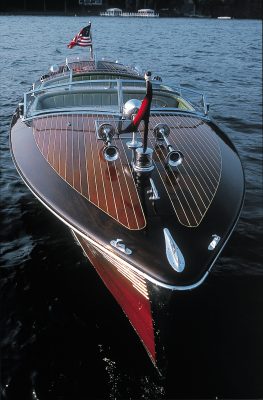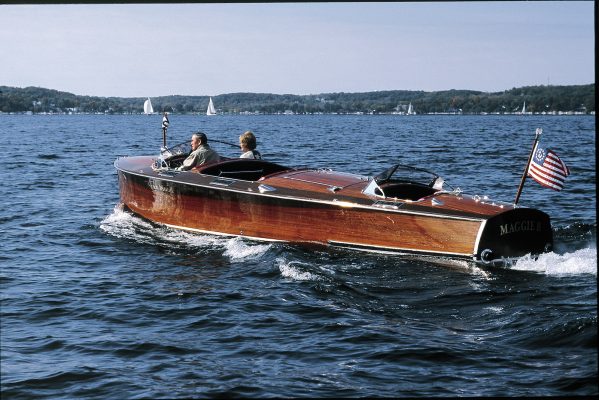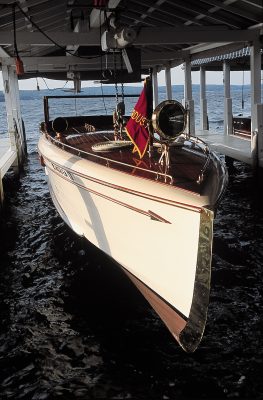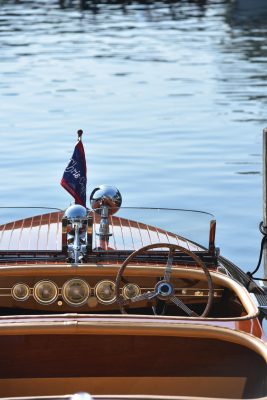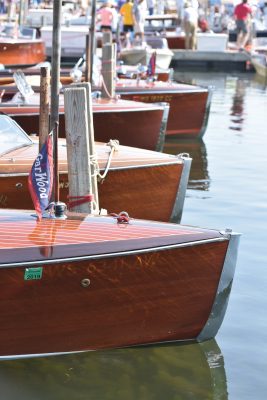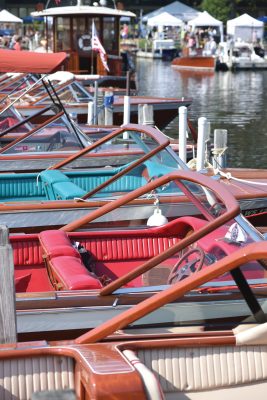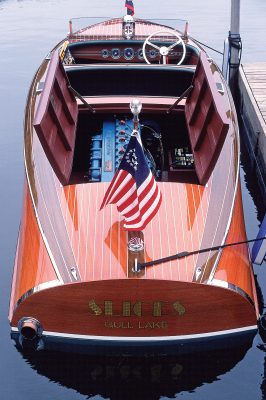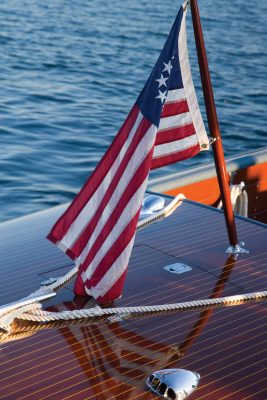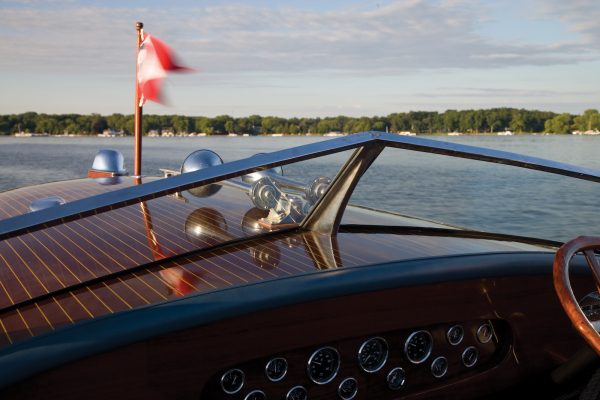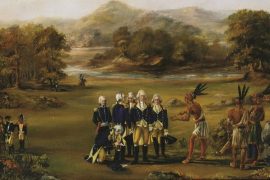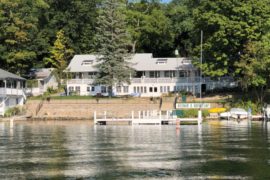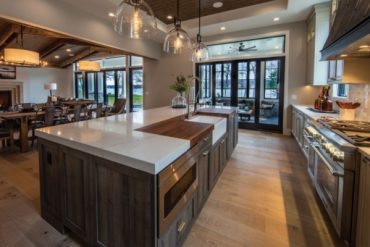By Holly Leitner
Editor’s note: Since this article first appeared in 2011, there have been new additions to the wooden boat building community in the Geneva Lake area. The article has been re-edited and updated to reflect the current landscape.
A wooden boat is a true labor of love requiring many hours of maintenance with much heart and soul. With low-maintenance fiberglass options cutting across the water so effortlessly, you may wonder: why do people bother?
“There’s something about wood that’s very sensual,” said Larry Larkin, a local expert on wooden boats and antique boat restoration. “Fresh varnish is almost narcotic-like, the way the wooden boat rides, feels … whereas fiberglass is like driving a tin can in comparison.”
Lake Geneva became a favorite summer destination after the Great Chicago Fire of 1871, helped by the completion of the Chicago & Northwestern train line to what was then a rural village. A “resorting” culture was born. Wealthy Chicagoans built beautiful refuges from the city, and their luxury homes sprung up along the shoreline. The only way to reach many of these lake homes from the train depot was by boat, and the municipal piers were filled with public and private steam yachts meeting summertime residents and delivering them to their homes. Word spread about the “Newport of the West,” and more Chicagoans flocked here, many of whom wanted to own their own boats. From these customers, the local boat-building industry was born.
“Lake Geneva is perfectly fitted for wood boats,” mused Randy Streblow of Streblow Custom Boats. “This lake has all types. It’s a big lake and can handle it.”
The Early Years
Some of the early lake vessels were sailboats and steam-powered yachts, or small rowboats and fishing boats constructed by just a few craftsmen in town. According to Larkin’s research, in the 1870s, “a quick-witted English immigrant” named Napper set up shop at what is now Library Park in downtown Lake Geneva. Napper and his crew could build a steam yacht from local wood over the course of a winter.
At the same time, Napper was also building sailboats and small fishing boats. The first annual Fourth of July races were held, and in 1876, several summer residents formed the Lake Geneva Yacht Club. Sailboats of the era were known as “sandbaggers,” because the sailors had to perform a delicate dance on the vessel in order to move heavy sandbags side-to-side to balance the boat with the wind as the lake’s waters were churning.
Around 1900, steam yachts began to be replaced by yachts with gas-powered engines. By the early 1910s, the gas-powered speedboat was born, and had the ability to reach previously unheard-of speeds, as high as 15 miles per hour. The modern concept of lake life had really begun.
One vintage example of the era that is still on the lake today is the Stardust, built in 1913 as the ultimate speedboat. A high-powered motorboat designed to displace water with its hull, the Stardust cuts through the water rather than sliding over the water like modern planing boats do today. At this time, most gas-powered marine engines were converted from airplane engines. However, when the United States entered World War I, the government developed many new marine engines for use by the military. When the war ended in 1918, a surplus of these new engines appeared on the market, ready to power the nation’s leisure boats.
The Luxury Era
By the 1920s, three national boat builders had sprung to the forefront of the market: John L. Hacker of Hacker-Craft; Chris Smith of Chris-Craft Boats; and Garfield Wood, aka “The Gray Fox,” of Gar Wood Boats. Each man stamped his personality on the vessels he made. Hacker was known for his elegant style; Smith for his convenient runabout design; and Wood for speed. What these boats all had in common was a high level of quality.
“The shear line of a Hacker — no one could draw that line like John Hacker could,” said Larkin, adding that Hacker’s attention to grace and detail made a lasting impact on boat design.
With the completion of U.S. Highway 12 between Chicago and Lake Geneva in the 1920s, boat owners could hit the road with a trailer in tow, carrying these high-performance, quality wooden boats with them on vacation. “Route 12 opened up the way to Lake Geneva, and brought the speedboats to life,” said Larkin. With the completion of the highway, the demand for Napper’s local, utilitarian, rough-oak lumber boats disappeared. Instead, boats like the Philippine Mahogany Chris-Craft began to dominate the lake. Napper and other local wooden boat builders faded into yesteryear.
In the “Roaring Twenties,” people were dancing at night and boating by day. The soaring stock market meant more and more wealth from Chicago arrived every day, and many fashionable lakeside estates were built. The new lake set had developed a taste for glamour, and local, handmade products fell out of favor. Instead, they opted for wooden powerboats, custom fit with top-quality wood, brass railings, Belgian lace curtains, beveled glass, leather trim and Oriental rugs.
Downslide: The Great Depression
Then in 1929, the rollercoaster of the stock market plummeted. All the jazz and glitter of the ’20s was killed by the Depression of the ’30s. Hacker went bankrupt. Chris-Craft limited production and later produced utilitarian boats for the war effort. Of the Big Three, Gar Wood Boats remained the least affected by the crash, as Wood had already made his millions inventing the hydraulic dumptruck lift.
“[The Depression] really had a big effect on the lake culture,” said Larkin. Luxury was quickly stripped back to core practical concerns. However, after World War II, luxury boats once again began to start their engines. Wooden boats graced the waters again in larger numbers beginning in the 1950s. But then, the industry perfected fiberglass molds.
“By 1960, it was like a switch was flipped, and everything was fiberglass,” said Larkin. Suddenly, wooden boats were a relic of a bygone era, and no one seemed to miss their personality. Gone were the days of difficult-to-maintain wooden boats. Those boats were suddenly considered lesser quality; people wanted fast, easy and reliable boats, and fiberglass delivered and dominated the market. Wooden boats were abandoned, burned for metal or shoved away to rot in forgotten barns.
“The pain of the old boat, if you can get it to run, is you just put your knee there, pull, push, learn how many pumps before it goes, soak it long enough, and if all goes right, if you’re lucky, it might start…” said Larkin, who owns Alouette, a new boat based on Hacker-Craft’s triple-cockpit design. “That’s the nature of the beast.”
Reawakening: Re-creation of Recreation
But then, in 1980, the pendulum swung again, and suddenly there was a re-emergence of love for wooden boats. People who had grown up spending their summer in the back of their family’s wooden boat remembered the warm, nostalgic feel of them. They wanted that piece of their youth back. A market for the old, wooden boats began to blossom. People pulled their discarded boats out of barns and fixed them up, piece by piece. The Antique and Classic Boat Society (ACBS) was founded in the Finger Lakes region of upstate New York, a place topographically similar to the Geneva Lake area. The membership of the ACBS grew on a national scale, with the goal of preserving and restoring antique and classic boats.
Once these vintage wooden boats returned to the water in large numbers, the craze spread further. Everybody, it seemed, had to have one. And during this era, people had the luxury of being choosy. They didn’t just want an old Hacker-Craft, they wanted a Hacker-Craft from the prime year of 1935, or a rare Chris-Craft Barrelback, and could search the country until they found it.
It was a golden era for scouting wooden boats, and these early collectors had their top pick of pedigree boats. In turn, this renewed interest in the older models brought wooden boat building companies back to life. Hacker-Craft began making boats in greater numbers again; Williams Bay’s own Gage Marine had already teamed with Hacker to create the Gage-Hacker, a new vintage-style wooden boat customized for Geneva Lake. While John Hacker had long passed on, his legacy continued.
By 2000, the boat-collecting market was considered dry by most; all the best vintage boats had been snapped up and even the second-choice boats became collectibles. Boats that had once been dime-a-dozen runabouts were now collectibles. At the same time, boat building went back to its local roots. Streblow Custom Boats moved to Walworth in 1987. The well-built Streblow quickly became an icon of Geneva Lake; today more than 150 of them call the area home. Additionally, Lake Geneva boat builder Bergersen Boat Co. makes classic wooden Shepherds from vintage schematics, and in 2021 wooden boat builder Grand Craft relocated its workshop from Michigan to Genoa City.
And so, there’s a new chapter in the history of wooden boats. Today, of course, there are many boats on Geneva Lake, from sailboats to ski boats to the new/old “classics.” The love of the wooden boats lives on here, and from the looks of the lake, we suspect we’ll still be writing about them for years to come.
The Big Three
In the 1920s, these boat builders helmed companies that dominated the market.
JOHN L. HACKER, Hacker-Craft Boats
Hacker’s most popular boats, the Belle Isle Bear Cats, were owned by such famous figures as J.W. Packard and Henry Ford. Early in his career, Hacker even designed a floating biplane for the Wright Brothers. The Hacker Company was extremely successful by the beginning of the 1920s. In 1921, the company expanded and by 1928, Hacker-Craft boasted sales totaling $450,000, equivalent to more than $5 million today.
GARFIELD WOOD, Gar Wood Boats
Gar Wood came into the boat industry by pure love of the sport. A born inventor, at one time he held more U.S. patents than any other living American. At age 17, he invented a downdraft carburetor that enabled his inspection boat to outrun other inspectors, but he was perhaps most famous for his hydraulic hoist for dump trucks. For Wood, boating was a beloved hobby, and he wanted speed. He was the first man to reach a speed of 100 miles per hour on water.
CHRIS SMITH, Chris-Craft Boats
It’s said Chris Smith built his first boat at age 13, and from then on, his obsession for perfection continued. By 1881, he and his brother produced boats full-time, and in 1922 they partnered with Smith and Sons Boat Company. At this time, the team built a plant in Michigan, where they could produce boats on an assembly line, making Chris-Craft runabout boats available to the middle class.

